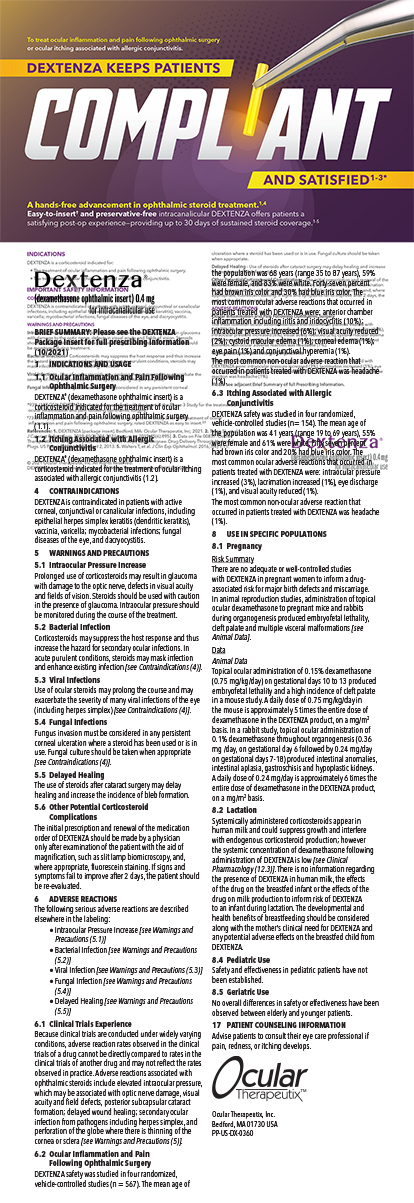For the great majority of patients, my go-to lens choice for presbyopia correction is the Crystalens HD (Bausch & Lomb, Rochester, NY) implanted bilaterally. I target emmetropia for the dominant eye, on which I operate first. Then, at 1 week postoperatively, I assess how the patient judges the IOL's performance and plan surgery for the following week.
Generally, if the patient is doing well but expresses a desire for more near vision, I target -0.50 D for the nondominant eye. I know that this final refractive outcome—combined with the benefit of bilateral summation, accommodative arching, and whatever pseudoaccommodative mechanisms are present—will result in a happy patient with at least J3 or better UCVA at near and crisp, high-quality distance vision.
Happy patients refer more people to my practice by the best and least expensive tool for practice growth—word of mouth—just as unhappy patients can be extremely detrimental to a premium IOL practice. I forewarn patients preoperatively that no current lens implant is perfect and that reading glasses may still be required for small print or poor lighting conditions.
For some patients who tolerated monovision in the past and wish to have a particularly close near point, I may target -0.75 to -1.00 D for the nondominant eye. I find that the enhanced near performance of the Crystalens HD over the Crystalens 5-0 rarely requires any further offset to satisfy the great majority of patients, thereby avoiding compromises in stereopsis or bilateral contrast sensitivity inherent to full monovision of -1.50 D or greater.
The decision to favor bilateral implantation of an accommodating lens over multifocal IOLs is predicated on a basic tenet of medicine: Primum non nocere (first, do no harm). Currently, I cannot predict preoperatively which patients with multifocal IOLs will be troubled by photic phenomena or will have poor neural adaptation, possibly resulting in the need for IOL explantation.1 The average lifespan for men and women living in the United Kingdom today is 76 and 81 years, respectively. I cannot predict with certainty which patients will develop age-related comorbidities that could later compromise their contrast sensitivity, such as optic neuropathy, glaucoma, diabetic macular edema, or age-related macular degeneration.
Implanting a multifocal IOL that compromises contrast sensitivity at various spatial frequencies in exchange for multifocality may further impact these individuals at some future time. Some multifocal IOLs split the light energy continuum differently between primary foci based upon pupil size, and we know that a patient's pupil size, shape, and dynamics often change with aging. Thus, there may not be a guarantee that the IOL's function today is predictive of its future function. One study comparing a monofocal and multifocal IOL showed reduced contrast sensitivity within each group with increased age and greater satisfaction with the multifocal IOL in the younger cohort.2 Others have similarly reported a higher frequency of glare disability and halos in older versus younger pseudophakes.3
MODIFICATIONS
There are occasions when I modify my usual plan based upon my assessment and identification of a patient's particular needs and expectations. For the occasional patient who wants a close near point, such as someone who knits or collects stamps, or someone who cannot tolerate any disparity between the eyes for distance when monovision is demonstrated preoperatively, I may consider implanting the Crystalens HD in the dominant eye and an aspheric AcrySof Restor IOL (Alcon Laboratories, Inc., Forth Worth, TX) in the nondominant eye, with both targeted for emmetropia.
Our studies have shown great patient satisfaction with this accommodating IOL/multifocal IOL combination and an in-between effect on photic complaints and decreased contrast sensitivity compared with the bilateral implantation of either lens.4
After appropriate informed consent, I have implanted aspheric Restor IOLs bilaterally in a few patients who did little night driving or computer work and whose main goal was knitting, reading at a close focal point, and watching television.
As other diffractive IOLs become available in the United States, I will likely rely on differences in reading speed to decide which of these to implant in the nondominant eye in these unusual circumstances.5 It goes without saying that for any IOL combination, it is crucial to surgically correct corneal astigmatism.
My first choice, however, is to avoid decreasing the patient's contrast sensitivity and challenging their neural adaptive ability. Primarily choosing a bilateral implantation of the Crystalens HD avoids the compromises in retinal image quality inherent to multifocal IOLs that split light.
This article is reprinted from Cataract & Refractive Surgery Today Europe's October 2008 edition.
Jay S. Pepose, MD, PhD, is a Professor of Clinical Ophthalmology and Visual Sciences at the Washington University School of Medicine and Director of the Pepose Vision Institute, St. Louis, Missouri. He is a consultant to Bausch & Lomb. Dr. Pepose may be reached at (636) 728-0111; jpepose@peposevision.com.
- Pepose JS. Maximizing satisfaction with presbyopia-correcting intraocular lenses: the missing links. Am J Ophthalmol. 2008;14695/:641-648.
- Jacobi PC, Konen W. Effect of age and astigmatism on the AMO Array multifocal intraocular lens. J Cataract Refract Surg. 1995; 21(5):556-561.
- Dick HB, Krummenauer F, Schwenn O, Krist R, Pfeiffer N. Objective and subjective evaluation of photic phenomena after monofocal and multifocal intraocular lens implantation. Ophthalmology. 1999;106(10):1878-1886.
- Pepose JS, Qazi MA, Davies J, et al. Visual performance of patients with bilateral vs combination Crystalens, ReZoom, and ReSTOR intraocular lens implants. Am J Ophthalmol. 2007;144(3):347-357.
- Hütz WW, Eckhardt HB, Röhrig B, Grolmus R. Reading ability with 3 multifocal intraocular lens models. J Cataract Refract Surg. 2006;32(12):2015-2021.


